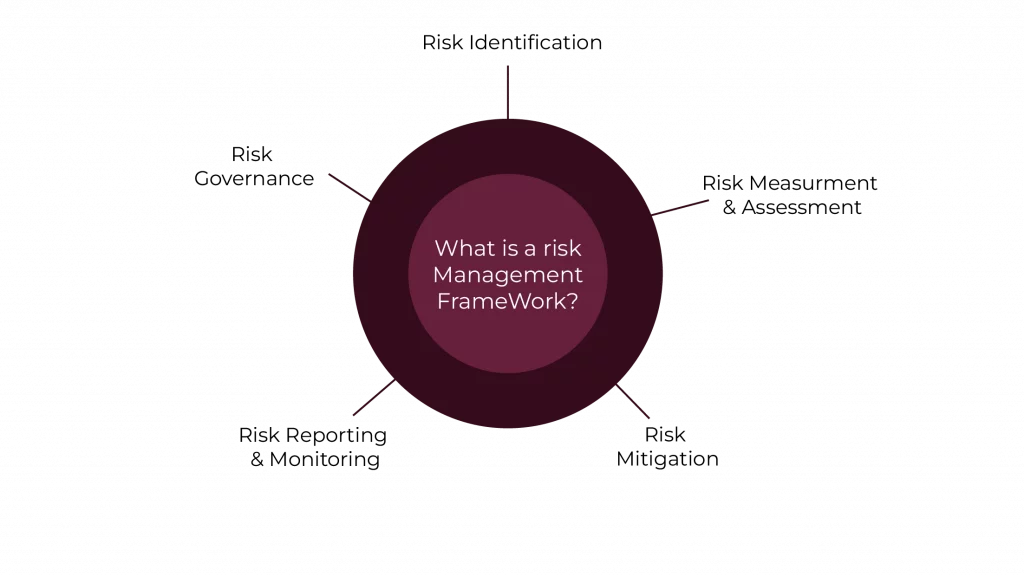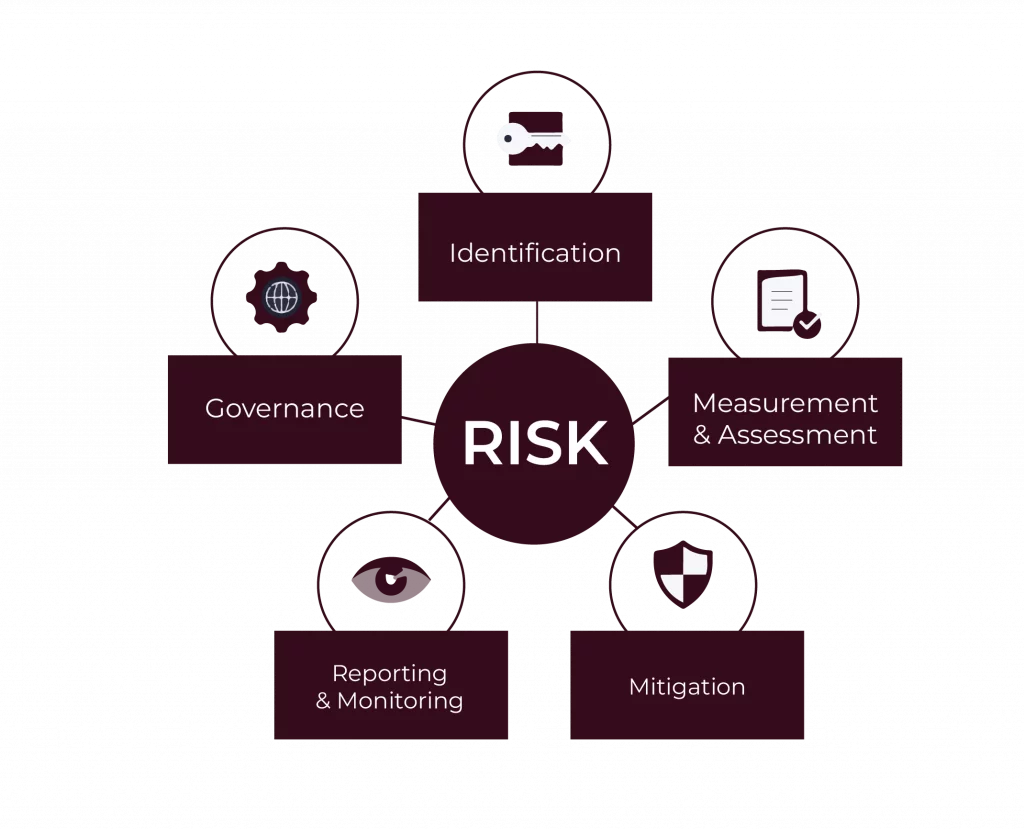In an uncertain world, businesses face uncertainties and risks that could disrupt business operations, hurt trust, or affect growth. Be it through cyber breaches, compliance failure, or merely downtime for operational requirements, the management of these risks determines long-term success.
Without an organised structure, organisations could be completely cornered by issues that would have easily been resolved.
This is where a risk management framework (RMF) plays a highly critical role. An RMF can offer a systematic methodology to identify, evaluate, mitigate, and monitor risks. This acts as a strategic guide wherein the organisation can plan to stay prepared and resilient within the fluid landscape.
In this blog, we will look at the key components of RMFs, the risks they address, and how automation is revolutionising their application. In the end, you will know how an adoption of an RMF not only secures your business but also sets up a foundation for sustainable growth.
Why Businesses Cannot Thrive Without a Robust Risk Management Framework
Running a business is like driving on a busy highway. There is a speed limit, signals, and guardrails to keep us safe. Consider that a risk management model is something like the guard rails for your enterprise. It keeps us from deviating from the straight course when risks occur.
Here’s why it’s critical:
| Protects Your Assets | Prevents Downtime | Ensures Compliance |
| Whether it’s data, financial assets, or intellectual property, RMFs shield what matters most. | Risks like cyberattacks can halt operations. A solid framework keeps disruptions minimal. | With regulations like GDPR or HIPAA, fines can be steep. RMFs help businesses stay compliant. |

POSTGRADUATE PROGRAM IN
Financial Analysis, Valuation, & Risk Management
Learn financial modeling, valuation techniques, and risk management to drive strategic business decisions.
Breaking Down the Core Components of Risk Management Frameworks
An RMF might sound complicated, but it’s straightforward when broken into its key parts. Let’s look at the building blocks.

1. Risk Identification
We can’t fix what we don’t know is broken. The first step is to identify risks that could harm the business.
Examples include:
- Cybersecurity threats like ransomware.
- Regulatory risks from non-compliance.
- Operational risks such as supply chain disruptions.
2. Risk Assessment and Measurement
Not all risks are equal. Some are more likely to happen, while others could have severe consequences.
Here’s how we assess them:
- Likelihood: How probable is it that this risk will occur?
- Impact: If it does occur, how much damage could it cause?
3. Risk Mitigation Strategies
Once risks are identified and assessed, it’s time to act.
- Strengthen cybersecurity measures.
- Establish backup systems for critical operations.
- Invest in training to reduce human errors.
4. Risk Monitoring and Reporting
Risks evolve, and so should our strategies. Regular monitoring ensures that we stay one step ahead.
Tools like automated dashboards help us track risks in real time.
5. Risk Governance
Every employee plays a role in risk management. From the top executives to entry-level staff, clear responsibilities ensure that nothing slips through the cracks.
Also Read: A Detailed Guide to the 5-Step Risk Management Process
Example: Risk Management in Action
Let’s take a practical example:
Imagine a mid-sized Indian tech company handling sensitive client data. Their risks include:
- Data breaches due to weak passwords.
- Compliance issues with local data protection laws.
Here’s how they tackle it:
- Identification: Assess all access points where data could be compromised.
- Mitigation: Implement two-factor authentication and regular staff training.
- Monitoring: Use tools to detect unusual activity in real-time.
This framework ensures they’re not only compliant but also well-prepared for potential threats.
Key Benefits of Risk Management Framework
It is not at all about just checking the boxes. It delivers very tangible benefits that position your organisation ahead of the curve.
| Improved Decision-Making | Enhanced Trust | Cost Savings | Business Resilience |
| We get a clearer view of potential risks, enabling us to make informed decisions. | Clients and partners are even more assured when they know their information is safe. | Mitigating problems is way cheaper than solving them after they have occurred. | Preparedness will prevent businesses from flailing during times of crisis, ensuring continuous smooth operations. |
Common Risks Addressed by Risk Management Frameworks in Modern Businesses
Every organisation faces risks. But not all risks are created equal. Some threaten data security, while others affect compliance or operations. Let’s break down the most common risks and how an RMF helps mitigate them.
Cybersecurity Risks
Cyberattacks are increasing and targeting businesses of all sizes. A stolen password or a phishing email could damage your operations. For instance:
- Ransomware: Encrypts your files, demanding payment for access.
- Data Breaches: Hackers steal sensitive information, damaging trust and inviting fines.
An evolved risk management framework provides your business with the tools to detect threats, secure systems, and quickly recover.
Implementing straightforward measures such as activating two-factor authentication can significantly increase security.
Compliance Risks
Ever-changing regulations constantly put companies at risk of non-compliance. Laws like GDPR and India’s IT Act impose heavy penalties for failing to secure customer data.
Imagine a healthcare provider fined for failure to encrypt patient records. It is expensive, and it erodes trust.
With a risk management framework, compliance becomes part of your daily processes. You won’t just meet standards—you’ll exceed them.
Operational Risks
Picture this: Your supply chain halts due to unforeseen disruptions. Operational risks like these can cause delays, missed targets, and unhappy customers.
A good risk management plan will see all these types of risks coming and have backup plans ready. It’s like being a safety net that keeps running smoothly when anything goes wrong.
Financial Risks
Economic downturns, currency fluctuations, or fraudulent transactions—financial risks come in many forms. Businesses without safeguards risk losing revenue or even closing shop.
Risk frameworks help identify vulnerable areas, ensuring proactive solutions to minimise loss.
Reputational Risks
A single mistake, like mishandling customer data, can damage your reputation overnight. Losing trust means losing customers.
With risk management frameworks, you can monitor and address risks before they escalate, protecting your brand image.
Also Read: Quality Risk Management

82.9%
of professionals don't believe their degree can help them get ahead at work.
Step-by-Step Guide to Implementing a Successful Risk Management Framework
Implementing a risk management framework might seem complex, but breaking it down into steps makes it manageable. Here’s how we do it.

Step 1: Identify and Categorise Risks
Begin by mapping out risks across all areas of your business.
- Cyber risks? Look at system vulnerabilities.
- Compliance risks? Review data privacy laws.
- Operational risks? Study supply chain dependencies.
Categorise risks into high, medium, and low priorities based on their impact and likelihood.
Step 2: Conduct Risk Impact Analysis
Not all risks deserve equal attention. Assess their potential damage. Ask questions like:
- How severe would the impact be if this risk materialises?
- How likely is it to occur?
For example, a minor software bug might delay tasks but won’t halt operations, whereas a ransomware attack could shut down everything.
Step 3: Implement Mitigation Controls
This step is about action. Once risks are identified and assessed, measures are put in place to mitigate them.
Examples include:
- For cybersecurity risks: Encrypt sensitive data and train employees to recognise phishing attempts.
- For compliance risks: Regular audits and up-to-date documentation.
- For operational risks: Diversify suppliers to avoid dependency on a single source.
Step 4: Monitor Risks Continuously
Risks evolve. What seemed unlikely last year might be a top threat now. Regularly monitor your risk landscape using tools that offer real-time alerts.
For example, use software that flags unusual login attempts, helping you respond before issues escalate.
Step 5: Review and Improve
A risk management framework isn’t a one-and-done task. Regular reviews ensure it stays effective.
Update controls to address emerging threats and revisit past risks to see if mitigation strategies worked.
Overview of Globally Popular Risk Management Frameworks and Their Applications
Not all RMFs are equal. Each has a distinct purpose and is meant to serve different industries under various challenges. Here are the most widely applied frameworks.
NIST RMF
The NIST RMF thus focuses on managing cybersecurity risks. Though initially developed to suit the United States federal agencies, now it is used worldwide.
- Primary Steps: Prepare, Categorise, Select, Implement, Assess, Authorise, Monitor.
- Best For: Businesses with heavy IT dependencies.
COBIT
COBIT (Control Objectives for Information and Related Technologies) aligns IT governance with business goals.
- Core Principles: Evaluate, Direct, Monitor.
- Best For: Organisations seeking to improve IT efficiency.
ISO 31000
This international standard is all about flexibility. It applies to organisations of all sizes and sectors.

- Focus: Integrating risk management into decision-making.
- Best For: Businesses looking for a scalable framework.
Example: A Mumbai-based startup uses ISO 31000 to manage growth risks as it scales operations.
COSO
The COSO framework is simply about risk management in business.
- Main Components: Control Environment, Risk Assessment, Control Activities, Monitoring.
- Good For: Financial services and large corporations.
FAIR and OCTAVE
- FAIR (Factor Analysis of Information Risk): It quantifies the risks for crystal-clear decision-making.
- OCTAVE (Operationally Critical Threat, Asset, and Vulnerability Evaluation): It concentrates on the identification of critical assets and their vulnerabilities.
- Best For: Businesses handling sensitive data.
Trends in Risk Management: The Role of Automation and Advanced Tools
With the growing complexity of risks, businesses need smarter ways to handle them. Enter automation. Advanced tools are transforming how we implement and monitor a risk management framework, making it faster, more accurate, and far more effective.
Smarter Risk Identification
Manually identifying risks can take weeks, and even then, human error is a factor. Automation tools cut through the noise and pinpoint risks in minutes.
Automation helps you:
- Track evolving risks in real-time.
- Spot unusual patterns that might go unnoticed otherwise.
- Ensure nothing slips through the cracks.
Real-Time Monitoring and Alerts
Imagine getting notifications right when the trouble occurs. That is exactly what smart tools offer.
- They constantly monitor systems and risks as they evolve.
- Dashboards provide a quick view of all the risks, thereby saving time and effort.
Streamlined Compliance
Balancing evolving regulations would appear quite daunting. Automation tools improve compliance by monitoring necessary requirements and highlighting all deficiencies.
- Tools align the processes of your organisation with legal requirements.
- They highlight the areas in which you are poorly compliant.
Cost-Effective Solutions
The initial investment in automation appears costlier, whereas, in the long term, it yields considerable returns.
- Reduces manual work so that your team can focus on strategy-related work.
- Cuts costs by preventing major incidents before they happen.
Conclusion
A risk management framework is more than just a set of procedures; it represents a strategic approach to help organisations navigate uncertainty with confidence. This framework addresses important risks- from cybersecurity weaknesses to operational disruptions- while also ensuring compliance with regulations and improving overall efficiency.
With automation and advanced tools, frameworks become smarter, offering real-time monitoring, cost savings, and smooth processing. By selecting the appropriate framework or using the right tools, businesses can remain prepared and resilient.
Adopting a framework not only protects assets but also brings forth growth and stability amid an uncertain world. When risk management becomes the top priority, then there lies a solid foundation for long-term success.
To enhance one’s understanding and develop expertise in this vital domain, Hero Vired’s Certificate Program in Financial Analysis, Valuation, and Risk Management is one of the best. It mingles theoretical knowledge with practical insights that would help professionals acquire mastery in risk management and valuation.
What is a risk management framework?
What is the greatest benefit of automation?
Do we still need manual checks alongside automation?
Are these tools expensive?
Updated on December 10, 2024
